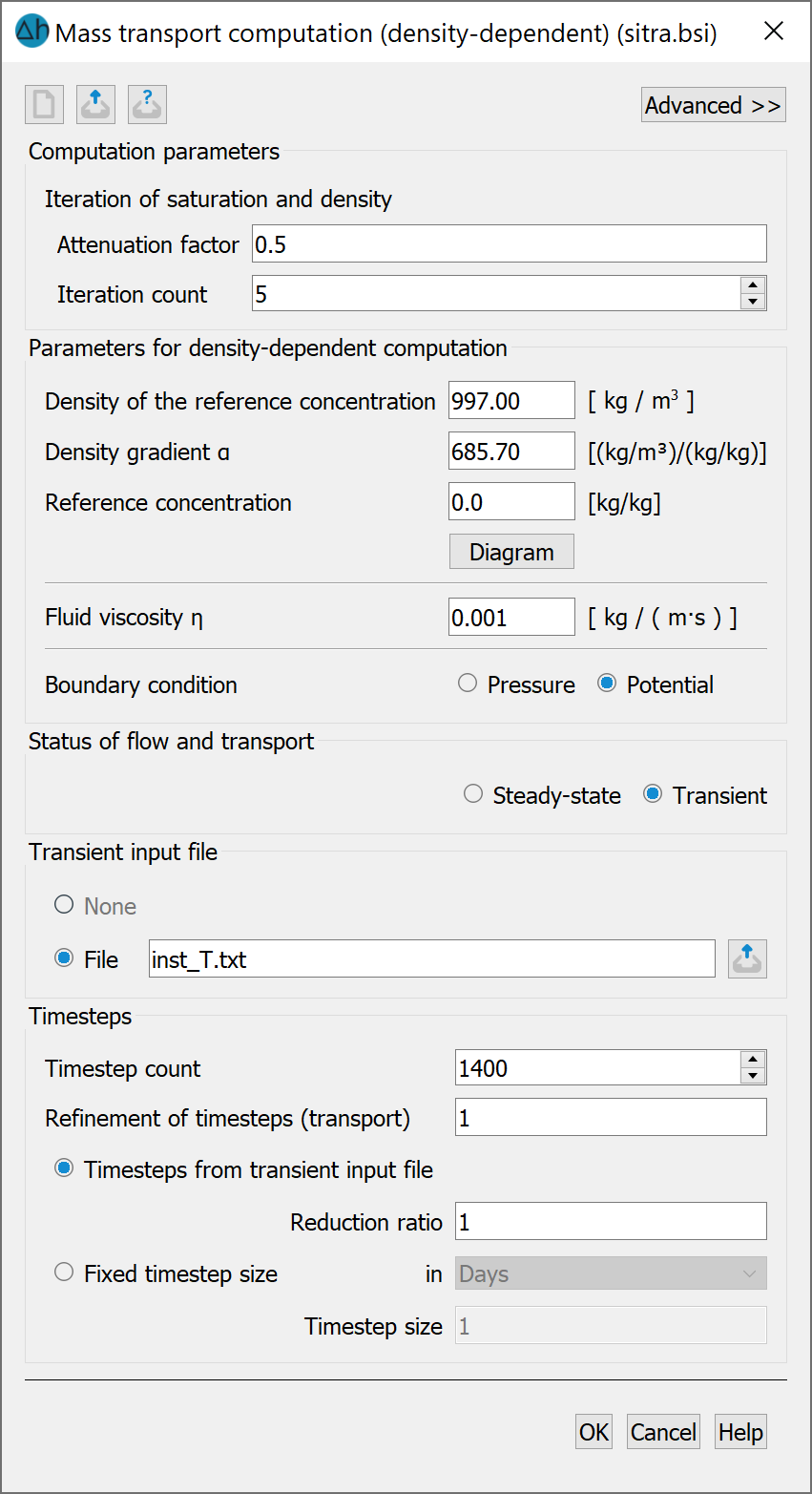After selection in the menu of Calculation  Mass transport (density-dependent)... the following input window appears:
Mass transport (density-dependent)... the following input window appears:

A density-dependent mass transport calculation is only possible with the SITRA module. When the input window is called up, the programme reads in the batch file with the default name sitra.bsi (if it exists). The default settings in the mask are changed accordingly if necessary.
In addition to the already known input parameters "State for flow and transport" and "Time step widths" (see "Mass transport input parameters"), the parameters for the change in density as a function of the mass concentration in the fluid are specified in the density-dependent mass transport calculation.
Iteration of saturation and density
The desired number of iteration steps and the damping factor are defined here.
Density parameters
Density ρ0 at the reference concentration c0 in [kg/m³]: ρ0 = ρ(c = c0), the default setting is ρ0 = 1000 kg/m³ Density gradient α = constant, the default setting is α = 0.0
Reference concentration c0 in [kg/kg], the default setting is c0 = 0 kg/kg
The associated diagram can be displayed and saved.
As a rule, the density of the reference concentration ρ0(c0 = 0) is known as well as the desired density ρ(c= cmax), cmax is usually the maximum concentration entered as 1KON or AKON.
This allows the density gradient α required in the dialogue to be calculated by rearranging the linear density function programmed in the SITRA programme module:
ρ(c) = ρ0 + α(c - c0)
to:

 , if c = cmax
, if c = cmax
ρ0 [kg/m³] = Density of the reference concentration c0 = 0
ρ [kg/m³] = known/desired density ρ(c = cmax),
c0 and cmax have to be entered in the unit kg/kg for the calculation of α.
Numerical example for SPRING:
Density of saltwater ρ(c) = 1021 kg/m³
Density of fresh water ρ0 = 997 kg/m³
Salt concentration c = 35 kg/m³,
The salt concentration c [kg/m³] must be converted from the unit [kg/m³] to the unit [kg/kg] for the calculation in SPRING:
ckg = c/1000 = 0,035 [kg/kg]
Insert into the formula to obtain:
α = (1021-997)/0,035 = 685,7 [(kg/m³)/(kg/kg)]
These figures are entered in the input dialogue as follows:

The corresponding density function looks like this:

Density as a function of salt concentration in [kg/kg]
These numbers can be found in the 5th line of the sitr file:
4th parameter of row 5: ρ0(c0) = 997.0 (kg/m³)
5th parameter of row 5: c0 = 0.0 (kg/kg)
6th parameter of row 5: α = 685.70 (kg/kg)/(kg/m³)
Special density function for salt (sea water)
If the 5th and 6th line parameters of the sitr file are set to -999, SITRA calculates with a special density function for salt (T = 20°C):
ρ(c) = 998,5 * (1+0,000765*c) = 998,5 + 0,7639*c
with:
ρ(c) = concentration-dependent density of the salt water [kg/m³]
Density at the reference concentration (fresh water): ρ0 = ρ(T=20°, c0=0) = 998.5 [kg/m³]
Reference concentration: c = c0 = 0 [kg/m³]
Regardless of the input for ρ0, the calculation is based on ρ0 = 998.5 kg/m³.
General density function for salt
The concentration-dependent density function for a salt solution (seawater) is generally as follows:
ρ(T,c) = ρ(T,c=0) * (1 + αs*c) = ρ0 + α*c
ρ(T, c=0) = ρ0 = density of the reference concentration [kg/m³]
αs: The factor αs depends on the proportion and type of dissolved salts and is for seawater (see above) at T = 20°C: αs = 0.000765 [m³/kg]
c = reference concentration [kg/m³]
α = density gradient of the straight line, α = αs * ρ0 [-]
Fluid viscosity
The fluid viscosity (or dynamic viscosity) η (for water: η(T=20°) = 0.001 [kg/(m s)]) is required because the pressure equation is used in the density-dependent mass transport calculation.
Boundary Condition
During the density-dependent calculation, the entered potential heads or water levels (EICH, VORF, POTE) are converted internally into the unit pressure using the familiar formula:
p = (h - z) * ρ * g [N/m²]
with:
p = pressure [N/m²]
h = Potential height [m]
z = Position height [m]
ρ = density [kg/m³]
g = gravitational acceleration [m/s²]
If the water levels are to be recorded despite a change in density, the "Potential" button (default) is activated.
p = (h - z) * ρ0 * g [N/m²] with ρ0 = ρ(c=c0)
If the water levels are to be corrected based on the change in density, the "Pressure" button must be activated.
p = (h - z) * ρ * g [N/m²] with ρ = ρ(c)
State of the flow and transport
In the density-dependent mass transport calculation, there is only the option for calculating flow and transport: either steady state or transient.
The buttons at the top of the input window allow you to reset the input parameters ( ), open an existing batch file (
), open an existing batch file ( ) or save the current batch file under a different name (
) or save the current batch file under a different name ( )
)
The "Advanced settings" selection leads to additional settings
